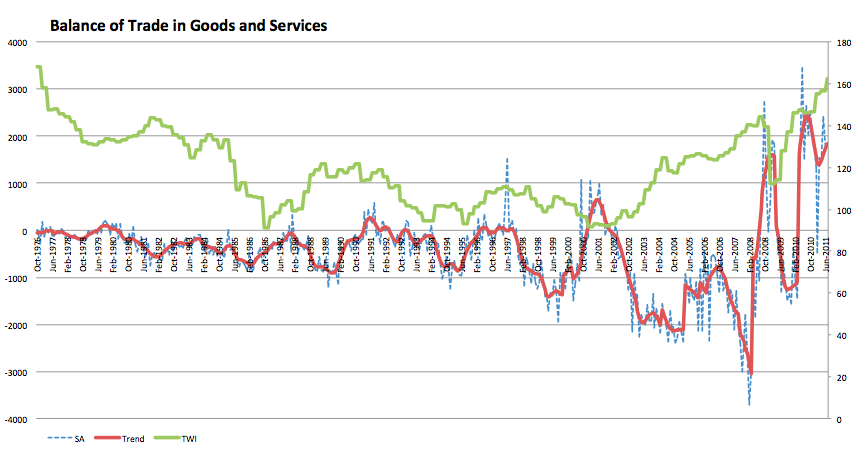The ABS today released their estimate of the balance of trade in goods and services for July. The headline data showed that trade surplus inched up a little in both trend and seasonally adjusted terms since June to around $1.8 billion. This is good news.
While the monthly release is extremely volatile, the surpluses over the past year have been nice to see.
I can’t help but raise the question about the impact of the currently strong Aussie dollar on our balance of trade. Intuition suggests that a strong dollar would reduce the balance of trade as our domestically produced goods become less attractive abroad, and foreign goods become more attractive sources for domestic consumption.
So I plotted below the balance in trade of goods and services against the Australian dollar trade weighted index (TWI). The intuition about the relationship between the balance of trade and the strength of the dollar appears to have held since the late 1990s.
However, the balance of trade has been extremely volatile over the past four years relative to the size of the movement in the currency. Also, the impact of the dollar on the trade balance appears to have weakened in the past year, leading to the unusual situation of a record high dollar and record high net exports of goods and services.
Given our intuition, one has to question how our exports have remained so strong recently at a time when the dollar remains near record highs?

One key factor at play is the composition of our exports. Currently the prices of our main exports – food, energy and minerals – are at record highs, and there are few substitute countries able to supply these goods. Some commentators have suggested that the current high commodity prices are as much the result of loose US monetary policy finding its way to commodity markets and foreign currencies, as they are a result of structural changes in demand due to growth in emerging economies. But maybe that’s a discussion for another day.
The current pattern also contains some interesting points for the great many people who (including myself) have suggested that a lower currency would ease the economic adjustments currently underway in Australia. It makes me question whether we should simply just sit back and let markets take their course, and cross our fingers that our luck continues.
Or perhaps not.
The point remains that we do find ourselves in unusual times. For all the poor economic data – the stagnation in GDP per capita, declines in home prices, and the recent uptick in unemployment – we find the near record high balance of trade position persisting.